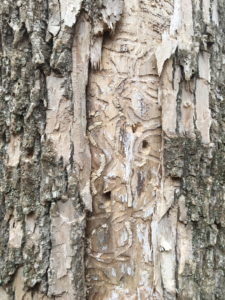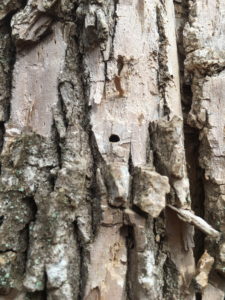The emerald ash borer (EAB), Agrilus planipennis Fairmaire, is a green jewel beetle native to eastern Asia. It was first found in the United States in 2002. Since then, these beetles devastated millions of ash trees. The adult beetles are emerald green in color and about 1/2″ in length. They feed on the ash foliage and typically cause little damage. It is the larvae that can cause significant damage. They feed on the inner bark of the ash trees and disrupt the trees’ ability to transport valuable nutrients. Adult EABs leave a characteristic D shaped hole, when they emerge from the tree in the spring. Woodpeckers love the larvae, and they feed on infested trees, causing even more damage.

There are several options for treating EABs. It is best to have an arborist determine whether your tree is a good candidate for treatment. Infestation can cause trees to lose 30% to 50% of the canopy after two years and die within three to four. Trees that are good candidates for treatment usually have at least 50% of their canopy still alive. The result of the feeding and tissue destruction from the larvae is directly evident in the canopy. Because many insecticides are transported through the trees’ vascular system, they may not work if the vascular system is already significantly damaged.

Issues to consider when deciding to treat or remove an ash tree infested with EABs include the following:
1. The health of the tree.
2. The financial and sentimental value of the tree.
3. The cost of the treatment and the prognosis.
4. The cost to remove the tree.
5. Optional, the cost to replant another tree.
It is never easy to determine when to remove a tree. Careful consideration should be taken to make the most cost effective decision.
Vic’s Tree Service
References:
Emerald Ash Borer Information Network
Insecticide Options for Protecting Ash Trees From Emerald Ash Borer